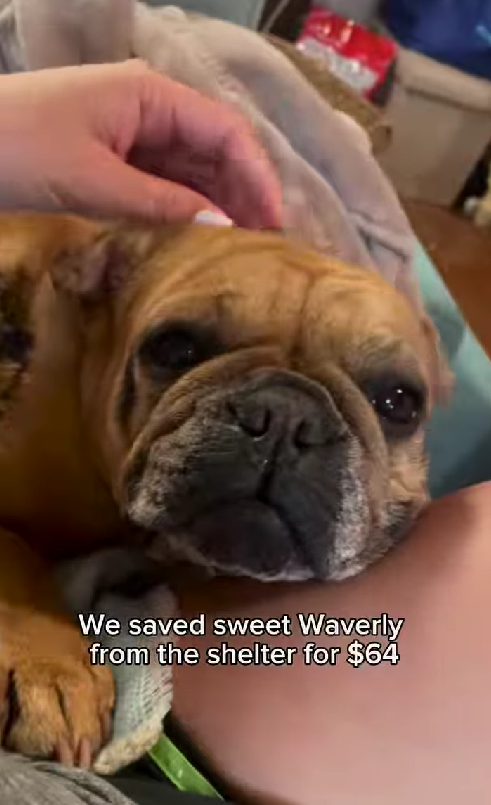What Is Cauliflower Ear in Dogs? One Dog’s $30,000 Tale of Survival and Love
Rescuing dogs often comes with significant financial challenges, and Waverly Moonthistle’s story exemplifies the cost of compassion. This French Bulldog, saved from a shelter for just $64, required medical care that ultimately exceeded $30,000 due to a severe case of cauliflower ear, leaving the rescue organization with a staggering expense.
Despite the financial burden, Roadogs Rescue remained unwavering in their commitment to Waverly’s recovery. Their efforts paid off as the Frenchie not only overcame her health issues but also found a loving forever home.
@roadogsrescue 🎄🐾Day 6 of our 12 Saves of Christmas – meet Waverly Moonthistle! Waverly holds a special place in our hearts as the most expensive dog this year, with a medical cost of nearly $30,000. Nobody goes into rescue, thinking they are going to be spending that kind of money but we had to repeat two TECA surgeries – and she deserved a chance. ❤️ Thank you to everyone who supports Roadogs. #fyp #frenchiesoftiktok #frenchielife #frenchielove ♬ The First Noel – Fadi Gaziri
Surviving Abuse and Multiple Surgeries
The Roadogs team shared Waverley’s story on social media, revealing that she had burn marks when they rescued her from the shelter, raising suspicions of past abuse. But that was just the beginning of the poor dog’s troubles.
Waverly’s body bore multiple scars and wounds, and her severely neglected ears had developed into cauliflower ears—a painful condition (read more about that below). The veterinary team at the Southern California-based rescue described it as the worst case they had ever encountered. An immense source of pain, Waverly’s untreated ear infections ultimately led to the dog becoming deaf.
With the rescue’s help, the dog underwent multiple surgeries, including two TECA-BO (Total Ear Canal Ablation and Bulla Osteotomy) procedures to address her severe ear condition.
In addition to her ear problems, the little canine also had cervical intervertebral disc disease, pulmonic stenosis, and airway syndrome.

From Medical Mess To Happy Ending
Despite enduring severe pain and health challenges, Waverly made a miraculous full recovery. Even better, the deaf dog was adopted by a loving and patient family.
Today, Waverly enjoys a pain-free life where she is finally getting all the love and cuddles she deserves. Roadogs credits her remarkable recovery to the generous support of their followers and donors.

“Every dog’s life is priceless, and Waverly’s incredible journey proves that no amount of money can measure the worth of giving a dog a second chance. Her recovery, and the love she found in her forever home, is a testament to the power of compassion and the importance of community support,” remarks Rocky Kanaka, a pet rescue advocate.
Netizens have understandably found Waverly’s journey to be incredibly heartwarming. An Instagram user, Val Isaac, wrote, “I’m not crying, you’re crying. 😭 Oh, my heart, I’m so glad she has gotten her forever family and home. Thank you for all you do to save these precious souls. 🫶🐾🐶💕🙏”
What is Cauliflower Ear in Dogs?
Waverly’s story is undeniably inspiring, but it also sheds light on a condition in dogs known as cauliflower ear. What is cauliflower ear in dogs?
According to experts at Vet Help Direct, cauliflower ear in dogs is a condition that occurs when a blood vessel in the ear bursts due to vigorous ear scratching and head shaking. This leads to the formation of an ear hematoma, which is a pocket of blood that collects between the cartilage and skin of the ear.
A pet owner, u/a_pig_with_a_shirt, has described their furry friend’s cauliflower ear condition on Reddit, “I have a Border Collie, German Shepherd mix … He’s been shaking his head frequently due to dry skin in his ears. We took him to the vet when one of his ears became super inflamed. It’s a hematoma in the ear called cauliflower ear from the constant shaking of his ear against his head.”
What Causes Cauliflower Ears in Dogs?
A cauliflower growth in a dog’s ear is often a symptom of an underlying issue, rather than a standalone disease. Veterinarians Krista Williams, Ryan Llera, and Ernest Ward say, “Most dogs that develop an aural hematoma have an infection, allergy, bite wound, or other inflammatory ear condition that causes excessive scratching and head shaking.”

As dogs scratch and shake their heads to alleviate discomfort, they risk rupturing the delicate blood vessels inside their ear flaps, leading to the formation of a hematoma.
In some instances, a foreign object like a tick or a piece of grass might be stuck in the external ear canal, triggering the issue. Alternatively, a foreign body might have initiated the shaking of their heads, only to be dislodged later.
Symptoms of Cauliflower Ears in Dogs
Cauliflower ears can present differently depending on their severity, and online pictures of cauliflower ears in dogs may not help you understand at what stage your dog is.
Mild cases may show localized swelling, often reddish or blue-purple in color, on a specific part of the ear flap. Severe cases, however, can result in the entire ear flap becoming significantly swollen, resembling a balloon. The swelling can vary in texture, from soft to hard, depending on the timing of the bleeding and the extent of blood clotting. While the affected area may be uncomfortable at first, it usually becomes painless over time.
Cauliflower Ear in Dogs Treatment
Cauliflower ears or ear hematomas in dogs typically resolve on their own within a few days but often result in permanent scarring and ear deformity. Prompt veterinary treatment is recommended to prevent this outcome. Treatment options vary depending on severity and dog tolerance, ranging from simple drainage with a needle and syringe to surgical procedures under anesthesia.
How To Treat Cauliflower Ear In Dogs At Home?
“You should not try to treat your dog’s ear hematoma at home because this can cause an injury or infection,” states Dr. Ghanasyam Bey. Ear hematomas can resolve on their own, but this may result in significant scarring and potentially cause discomfort and pain, especially for larger hematomas. Therefore, veterinary treatment is often recommended to address the condition effectively.
What is Total Ear Canal Ablation and Bulla Osteotomy (TECA-BO) in Dogs?
Waverly’s ear issues required two TECA-BO surgeries to treat her ear conditions. But what is a TECA-BO surgery? Dr. Malcolm Weir and Dr. Catherine Barnette explain, “This [TECA-BO] surgery involves the complete removal of the ear canal and tympanic bulla (middle ear), leaving only the pinna (ear flap) remaining.”
A TECA-BO surgery is typically recommended for dogs with chronic, severe ear infections that no longer respond to medical treatment. This procedure removes infected tissue, reducing pain and inflammation, and improving the pet’s quality of life. It’s often necessary when antibiotics are ineffective due to resistant bacteria or when scarring and inflammation have narrowed the ear canal, making cleaning ineffective.
TECA-BO Procedure
TECA-BO surgery is a complex procedure that involves removing the ear canal and middle ear. Before surgery, your dog undergoes a thorough assessment, including a physical exam, blood tests, and imaging studies like CT scans or MRI.
During surgery, your dog is under general anesthesia, and the surgeon removes the ear canal, eardrum, and middle ear bones. Infected material is removed and sent for bacterial culture to determine the best antibiotic treatment. The surgical site is then closed, and a drain may be left in place to allow fluid to exit.
TECA-BO surgery cost
As per Dr. Ghanasyam Bey, the cost of total ear canal ablation in dogs varies depending on location and whether one or both ears require surgery, ranging from $2,000 to over $4,000, with potential additional costs for complications.
FAQs About Cauliflower Ear in Dogs and Related Conditions
What causes cauliflower ear in dogs?
Cauliflower ear in dogs is typically caused by repeated trauma or untreated ear infections, leading to thickened ear tissue and fluid buildup. Chronic conditions like hematomas, infections, or untreated allergies can also contribute to its development.
What is a cauliflower ear in dog?
A cauliflower ear in a dog refers to a deformed, swollen ear caused by thickened tissue from repeated trauma, chronic infections, or hematomas. It often results in a lumpy or uneven appearance, resembling a cauliflower.
What is a total ear canal ablation in dogs?
Total ear canal ablation (TECA) is a surgical procedure where the ear canal is completely removed to address chronic ear infections or conditions that cannot be treated with medication. It’s a common solution for severe cases of cauliflower ear in dogs.
What is a TECA-BO procedure?
TECA-BO stands for Total Ear Canal Ablation with Bulla Osteotomy. This advanced surgery involves removing the entire ear canal and cleaning out the middle ear to resolve severe, recurring ear problems, including chronic infections and cauliflower ear in dogs.
How can I treat cauliflower ear in dogs at home?
While mild cases may be managed at home by cleaning the ear and reducing inflammation under veterinary guidance, severe cases of cauliflower ear in dogs often require professional treatment. Avoid home remedies without consulting a vet, as improper care could worsen the condition.
What should I do if I notice a cauliflower growth in my dog’s ear?
If you spot a cauliflower growth in your dog’s ear, it could be due to infection, trauma, or even tumors. Schedule a vet visit immediately to diagnose the cause and discuss treatment options, which may include surgery like total ear canal ablation.
What does a growth in a dog’s ear that looks like cauliflower mean?
A growth in a dog’s ear that resembles cauliflower might indicate chronic infections, tumors, or scar tissue from repeated trauma. Prompt veterinary evaluation is essential to determine the underlying cause and appropriate treatment.
What are the symptoms of cauliflower ear in dogs?
Symptoms of cauliflower ear in dogs include thickened, lumpy ear tissue, swelling, redness, discomfort, and possible drainage or odor from the ear. Chronic head shaking or ear scratching often accompanies the condition.
How do I know if my dog needs a total ear canal ablation?
A dog may need a total ear canal ablation if they suffer from chronic ear infections, severe cauliflower ear, or growths in the ear that don’t respond to medical treatment. Your vet will recommend this surgery if other options fail to resolve the issue.





